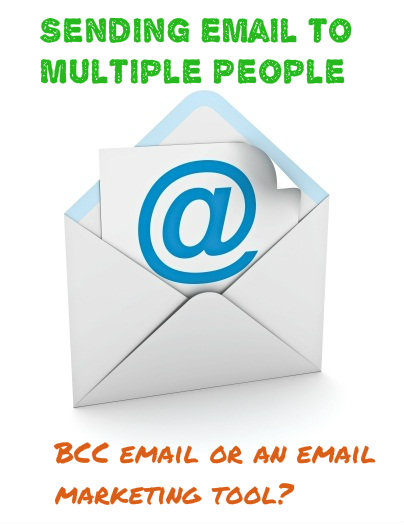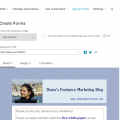
Sending email to multiple people is necessary sometimes. However, using bcc email address field is not always the right approach. Read on to learn when using an email marketing tool is better than sending a bcc email.
Use BCC email when sending a FYI type of email copy.
It can be personal or work related. Let me give you one example for each case to illustrate my point.
Let’s say you are planning a family getaway. You have discussed with your sister the city you are going to visit next month – but you have not decided on a hotel yet. She couldn’t care less about the exact place of accommodation so she leaves to you that decision.
You coordinate the accommodation with your favorite travel agency. You exchange several emails with them discussing requirements and various details. You finally like a hotel they have offered you. You make a reservation.
You want your sister to know what hotel you are booking but you don’t want to waste your time retelling everything that you have discussed with your travel agent. For that reason, when sending that last email to the agent with the reservation details, you also include your sister’s email in the bcc address field.
This way, your agent will get the reservation inquiry and in the same time, your sister will also get the reservation details and the emails history, if she needs more details of how the decision was made.
If you are wondering why use BCC and not CC address field – blind copy (bcc email) protects your sister’s privacy and email address. The other party (he travel agent in this case) does not see the email address which is inserted in the bcc email field.
The same logic can be applied if the email exchange was work-related and not personal. You discuss a design with your marketing department but you don’t want to involve the designer with the little details of the decision making process. However, once a design is approved, you want to notify the designer about it as well. You can do that with a bcc copy of that last confirmation email – for their information only.
Use an email marketing tool for your email marketing needs.
Never ever use BCC email when sending an email to multiple people as part of your email marketing efforts. For email marketing purposes, you should always use email marketing tools like MailChimp, ConstantContact, Aweber, and alike. There really are a lot of them out there. The one common thing for all of them is the recipients of your emails are willing participants.
It amazes me how many people use BCC emails to send their newsletter. That is very close to the definition of spam.
It is unethical (not to mention prohibited) to send a newsletter to someone who has not opted in to get it. It qualifies as unsolicited bulk email (UBE) and is one of the main reasons many small business owners without marketing knowledge think email marketing equals spam. Read more about email spam, if interested.
People should request you to send them email. You should never ever send email in bulk to your blog readers, for example, or to your client base, or to your existing customers, etc.
The only legitimate way for you to send them an email in bulk is if they have specifically requested to get emails from you that way. Email marketing tools have opt-in forms to facilitate that process.
In conclusion about blind copy emails and email marketing tools
BCC emails protect the privacy of the recipients when used right, but also sends the wrong message when used wrongly instead of an email marketing tool.
It’s ok to send a BCC emails to a single person or individuals who are somehow related to the conversation. It is definitely not ok to send blind copy emails in bulk to announce news, blog updates, product releases, and so on. Use an email marketing tool when sending email to multiple people.





Well that may answer a question as to why I get newsletters that I have never opted in for! It never occurred to me that I could be in a bcc.
ha-ha, well – those newsletters that you get but never sign up for – those most probably are just spam messages because someone put their hands on your email address. It’s easy to unsubscribe if you wish… although there’s no guarantee you will stop receiving them.
Usually you can tell if it is that or a bcc because the bcc emails are plain text emails (as if you are sending an email from outlook, gmail, or whatever email client you use) and the to field is the sender’s own email… This way you, being Jacqueline, are not really the recipient and yet, you receive it. No way to unsubscribe – the only option is to email back kindly requesting removal of your email address from the list or reporting for spam – depends if the sender doesn’t know better or he/she is shamelessly sending you spam 😀
I always wonder how irritated the recipients of unrequested mail will be, so generally avoid sending people anything they haven’t asked for. I regularly block senders who send me unsolicited content. As for the bcc versus marketing tool, the thing that makes the marketing tool work so much better is that it allows you to “personalize” the email. I’m much more responsive to something that starts with my name than when I feel I’m part of a bulk mailing.
Right, good catch on the personalization angle! You made me think about sending unwanted messages altogether… it’s a fine line and sometimes it’s ok, sometimes it’s not. For instance, that email i sent you last week about the Japanese guy – i sent it to you, personally, for this and this reason – and it was ok, although you never wanted me to send you that email.
If we add in the mix a couple of other bloggers who i might think are interested in the same story for their own blogs – i would still send it to you plus a couple of other bloggers, maybe with a bcc (to protect your privacy) or maybe several individual emails – and it would still be probably ok, although the email was not wanted.
However, if i like the story very much and decide to blast it via bcc email to all tens of bloggers with whom i network, regardless if the story would be interesting to them and/o good blog post topic idea – that would definitely not be ok, no matter if it is bcc or email marketing tool.
So, it all boils down to common sense and personal touch – deciding what to send to whom, when and how. Ah, when did everything become so complicated?! 😀
Thanks for adding to the conversation, Debra, AND prompting me to think about this from a different perspective 😉
Yes, getting a bcc: for something I don’t want is really annoying. I help some clients with their email marketing – glad they do it with subscription lists. It’s the unsubscribe line that I crave. Might convince to keep getting the emails, if they allow me to opt out.
Ah, so true, Leora – having a way out makes us more inclined to stay, doesn’t it?! Using BCC for business marketing is insane. I have not come across a business doing it lately – only fellow bloggers, hm – mommy bloggers mostly, really 😀
Well that may answer a question as to why I get newsletters that I have never opted in for! It never occurred to me that I could be in a bcc.
Hi, Bhavesh! Thanks for your comment – the strangest thing – Jacqueline here, first comment above, said the exact same thing – word for word! 😀